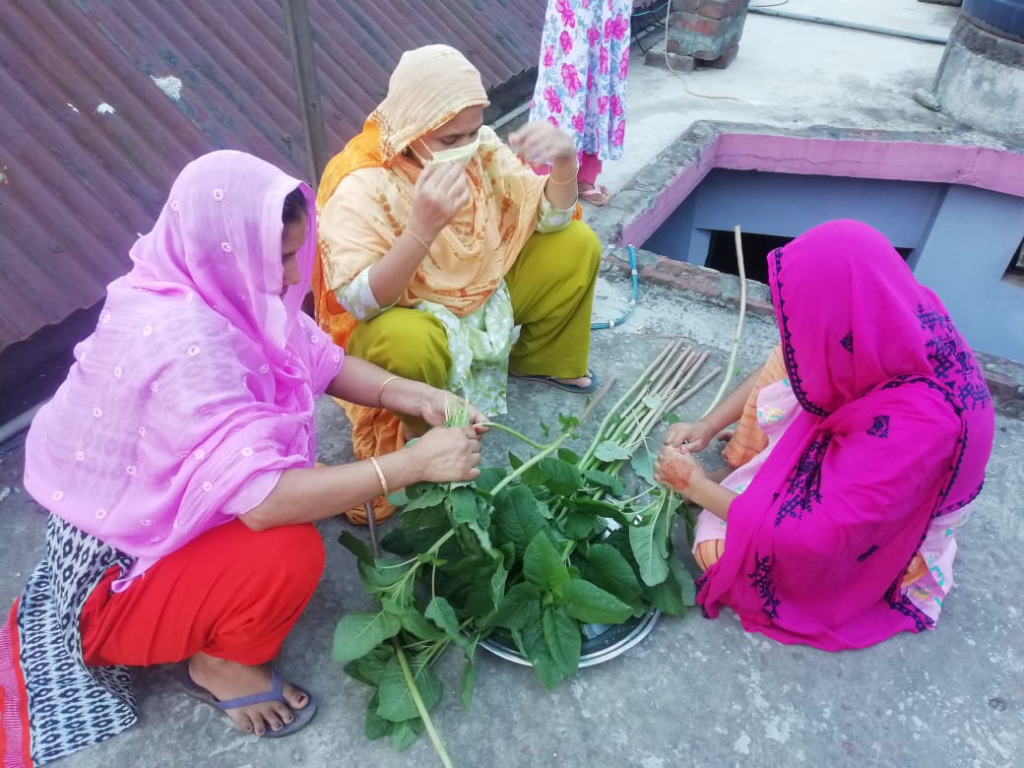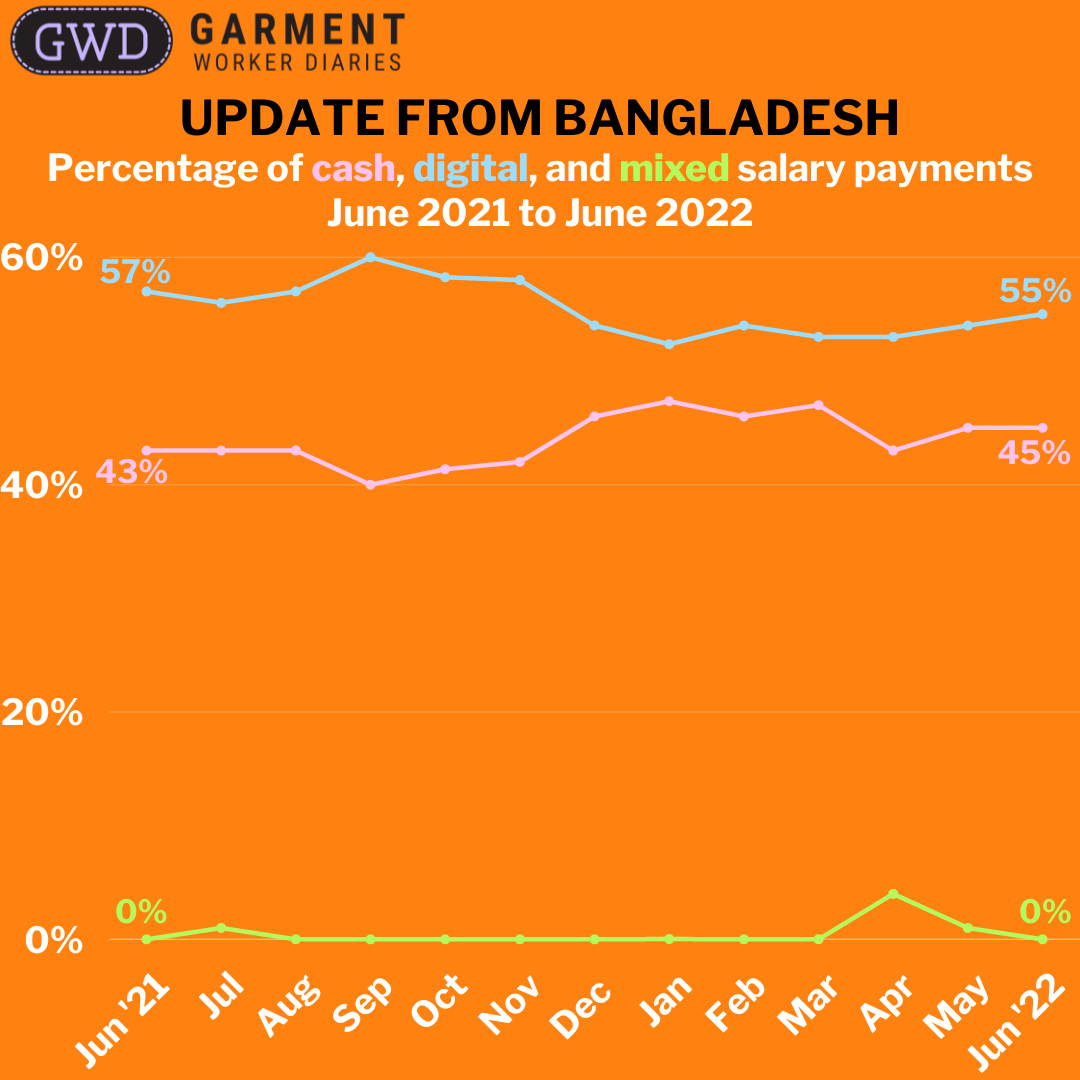In our last monthly update, workers took leave from work to celebrate Eid-al-Fitr and as a result, we noticed a decrease in the work hours as well as salary payments as they received their salaries in advance, in the previous month. This week we will provide a June 2022 update as we check how these variables have been affected in advance of workers observing Eid al-Adha in July.
Note: Banner photo courtesy of a garment worker in Bangladesh; numbers in graphs may not sum to 100% due to rounding.
Employment
83% of all garment workers went to work at some point in June 2022 (including 80% of women and 90% of men). The median work hours in June 2022 increased to 290 compared to the 220 reported in May 2022 (288 for women and 298 for men). This translates to a typical worker spending approximately 11 hours a day (10 hours of work and a one-hour break), six days a week in the factory during June 2022. This can be attributed to a familiar pattern that often occurs during the months preceding Eid, when workers report high work hours in anticipation of an Eid break in the following month. This was also the case in June of last year, when we reported that the median work hours increased to 282 (up from the 214 reported in May 2021) and then dropped to 183 in July 2021. Following this pattern, a decline in work hours is to be expected in July 2022, as workers take a break from work to celebrate Eid-al-Adha. We will report our findings in our next monthly blog.
One other thing to note, is, as we have reported elsewhere, the government changed the legal limit on work hours in a day, raising it from 10 to 12 hours per day (not counting break time). The data from June suggest that about half (52%) of the workers worked excess hours in June under the old regulations. Under the new regulations, 14% of workers worked excess hours (over 12 hours a day). We will be keeping our eye on whether the excess hours share creeps up—will 12 hours per day become the “new normal”?
Among respondents who did go to work in June but also missed at least one full week of work or more, 64% of respondents reported that they had quit working at their factory similar to what was reported in May. Other reasons for not working a full week such as being laid off (8%), sickness (7%), maternity leave (8%), and factory being closed (5%) were in line with other months.
Among respondents who were completely unemployed (meaning they did not go to work at all during May), the share of respondents who reported “quit” as the reason for not going to work was 74%, in line with previous months. Other reasons for not going to work were also reported in similar proportions to prior months.
Salary Payments and Eid Bonuses
81% of all garment workers received a salary payment in June 2022 (78% of women and 88% of men). As expected, the median salary reverted to its typical amount of Tk. 12,000 since workers went back to receiving their salary payments in the usual manner, that is receiving their salary payments a month in arrears. Women reported a median salary of Tk. 11,500 whereas men reported a median salary of Tk. 12,800. 55% of these payments were paid digitally compared to 45% paid in cash, in line with what has been reported in the previous months.
In preparation to Eid-al-Adha in July, workers started receiving their Eid bonus in June. By the end of June, 26% of the workers reported receiving an Eid bonus (24% of women and 32% of men), 73% of these bonuses were paid digitally, 23% were paid in cash and the remaining 4% were mixed. The share of workers that received a bonus in advance of Eid al-Adha is expected to increase in our next monthly blog when we consider the ones paid in July.
Financial Transactions
Intra-household transfers made within the household were similar to what was reported last month, with 31% of the workers reporting an intra-household transfer in June 2022. The amount transferred in June, Tk. 4,500, was higher than the amount transferred in May 2022.
The share of respondents taking loans was 33%, similar to what was reported in May 2022, but slightly higher than the 26% reported in April 2022. The median amount taken was Tk. 1,200 in both May 2022 and June 2022, less than Tk. 1,448 taken in April 2022. The main source of loans for the workers this month was still food bought on credit, which is in line with what has been reported in prior months after a dip in May 2022.
The share of respondents making loan repayments was 35%, an increase from the 23% reported in May 2022 but in line with the 33% reported in April 2022. The median amount repaid was Tk. 3,000 slightly higher than the Tk. 2,000 reported in May 2022 but in line with Tk. 3,000 reported in April 2022.
The share of respondents who transferred money to someone outside of their household was 15%, lower than the 22% reported in May 2022. The amount given was Tk. 3000, double Tk. 1,500 reported in May 2022. Over half, 54%, of the transactions were transferred digitally, 33% in cash, 6% were mixed (cash and digital), and the remaining 7% were a combination of digital transfer with in-kind gifts, cash transfer with gifts, or pure gifts. This is different to what was reported in May 2022 where cash was the dominant method compared to digital (69% vs. 17%). The difference in the mix of cash and digital transfers in the two months can be attributed to the fact that in May 2022 workers went home for the Eid break, were with their families, and were able to hand money to them in cash. In June, they were back at work, far from their families, and sent transfers digitally.
The monthly rent payment gap between men and women narrowed just a bit in June 2022, as 57% of women and 72% of men reported making a rent payment (61% of garment workers overall)
Food Security and Household Illness Update
Food insecurity rates were still slightly higher compared to those reported in April 2022 but more in line with those reported in May 2022: 11% of respondents, 10% of heads of households, and 9% of worker’s children experienced at least one week of food insecurity during the month.
Household illness rates in June 2022 remained almost identical to May 2022, with 20% of women, 18% of men, and 19% of workers overall reporting a household illness. Nearly every respondent who reported a household illness told us that medical attention was sought.
The data are drawn from interviews with about 1,300 workers interviewed weekly from May 2021 to June 2022. The number of worker responses in a particular month varies depending on interview participation rates throughout the month but were never below 1,210 during this period. These workers are employed in factories spread across the five main industrial areas of Bangladesh (Chittagong, Dhaka City, Gazipur, Narayanganj, and Savar). Just over three-quarters of the working respondents are women, roughly representative of workers in the sector as a whole.







